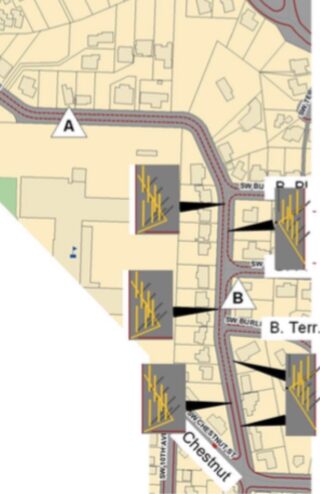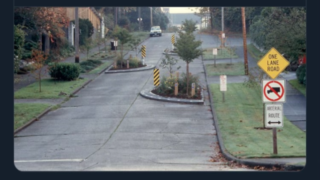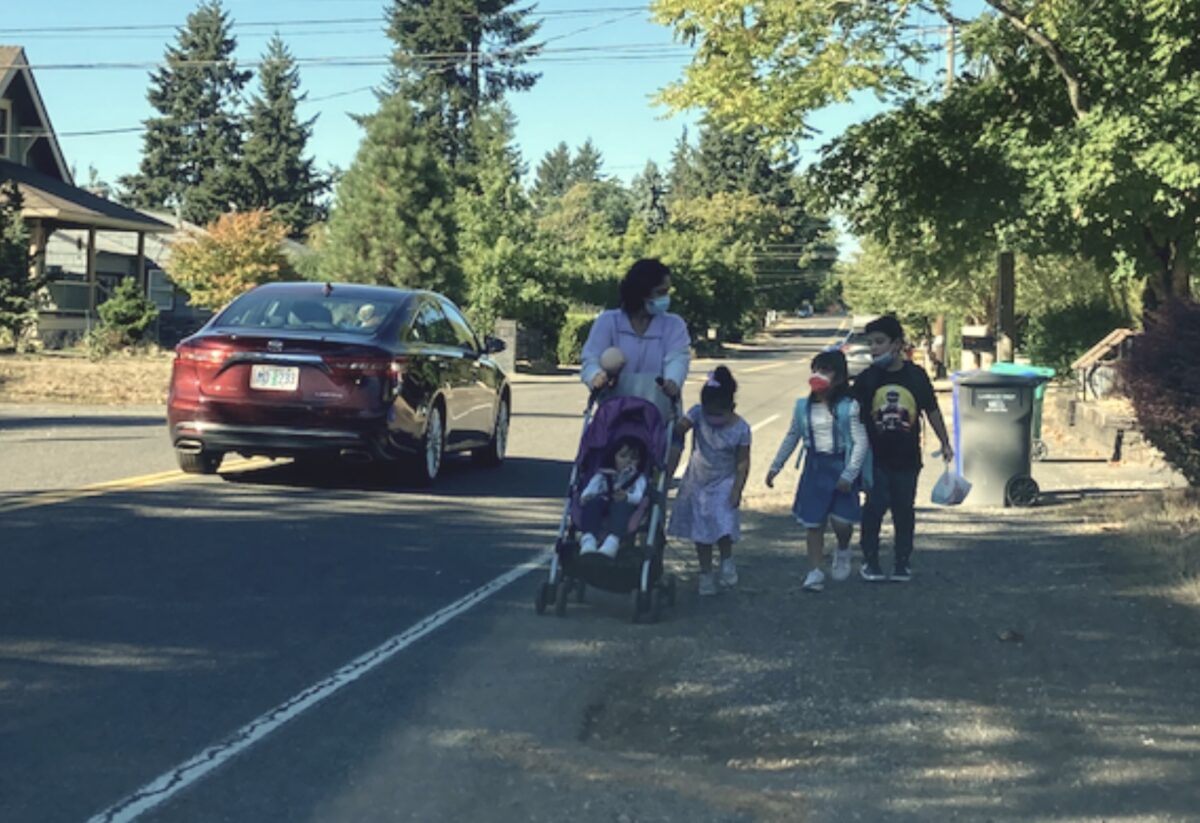

“Narrow residential roadways” come in different flavors—unpaved, unimproved, poorly paved, well-paved—and most, maybe all of them, don’t have sidewalks. As defined in Oregon statute (ORS 801.368) they are less than 18-feet wide and the speed limit is set lower than on wider residential streets. In the competition for safety funding, NRRs don’t have a high priority because they aren’t wide, high-crash corridors with posted speeds above 35 mph. But there are hundreds of NRRs in Portland, and when looked at in total they form a critical component of how we get around. Many of them need a small improvement, like a chicane, or speed bumps, to truly become places that people feel comfortable walking and rolling.
We need creative, inexpensive designs to reassert the right of people walking and rolling to have a place in the right-of-way.
I say, let’s take a page from the Portland transportation bureau’s pandemic response, their Safe Streets – Healthy Businesses program (which brought sidewalk and street dining to restaurants), and activate neighbors to improve these narrow streets themselves. PBOT already allows residents to paint their streets and close them for block parties, why not let residents select an appropriate treatment from a slate of low-cost PBOT designs, apply for a permit, and install it. Realistically, it is probably the only way to scale-up improvements to these low-priority streets, citywide.
Advertisement


(Source: PBOT report on project submitted by neighborhood.)
For example, in the Hillsdale neighborhood, SW Burlingame Avenue neighbors have clamored for traffic calming for two decades. Although narrow, Burlingame runs along Ida B. Wells High School, and connects Beaverton-Hillsdale Hwy to Barbur Blvd. Drivers speed along it. The street was the subject of a PSU student’s Capstone project, and the student’s design (at right) was reviewed by a PBOT engineer. My understanding is that Burlingame Avenue is currently on a PBOT short list for traffic calming, although I don’t know if this would be the design. In the spirit of improving our city, I’m going to use this project as a paper tiger.
As you can see from the graphic, this design relies on a large burden of plastic wands. According to the reviewing engineer, each one of those wanded wedges requires a yield sign—in each direction! Additionally, each wedge should have an advance “road narrows” warning sign, although given “current low speed and volumes,” a “generic warning north and south of the test site” could be used. The price tag ends up being around $8,000.
That’s a lot of signs and plastic for a little street.

Instead (and in the spirit of thinking outside the box) I imagine the clever designers at PBOT drawing up five or so inexpensive treatments for various street scenarios. A treatment could be as simple as a basketball hoop on the side of the road, or as elaborate as the chicane created from planters in the road (at right). Neighborhoods could apply for a permit to calm their narrow street, and select a PBOT-approved design. The process could include having the approval of some percentage of the residents. Grants could be available for neighborhoods which need financial assistance with materials.
East Portland

People have noted that southwest and east Portland face similar infrastructure inadequacies, and that is true. But I have yet to see a street in east Portland where I thought I might bump into a Hobbit, the way I often feel when I am in the Multnomah neighborhood. So a few weeks ago, I spent some time on 117th, between SE Market and Stark.
I didn’t measure the road, but it seemed narrow. I met Maria, who walks the roadway every weekday to pick up her two eldest children from the bus stop. She told me the road was awful to walk on and that “cars drive too fast and don’t slow down” for her. Unfortunately, that’s not surprising. Everything about this road tells the selfish driver that it belongs to them. As I stood on the shoulder a driver honked at me, maybe it was a warning honk, but it was loud enough to be a “why are you breathing my oxygen” honk. Nothing about the street says that Maria has a right to be there too. She deserves a promenade, or at least a row of trees, but that is a bigger project than a group of neighbors can support. We need creative, inexpensive designs to reassert the right of people walking and rolling to have a place in the right-of-way.
The statutory speed limit for a NRR is 15 mph, but Portland Ordinance 188774 directs PBOT to post non-arterial streets in residence districts at 5 MPH slower than their statutory speed, which would be 10 MPH. As we’ve urged before, they should do that.
When it comes to a relative easy way for us to address Vision Zero, give Portlanders a stronger connection to their neighborhoods, and create more people-centered streets — narrow residential roadways are Portland’s low-hanging, live-saving, fruit.

